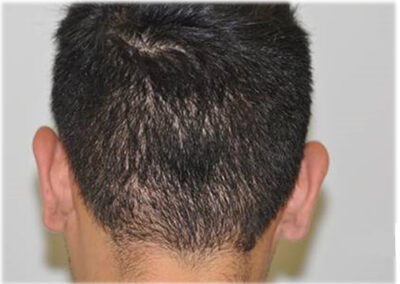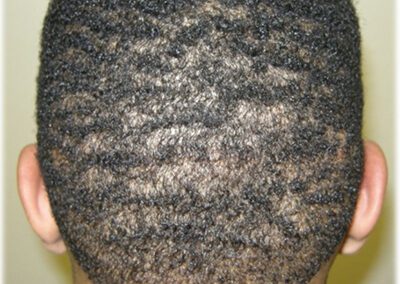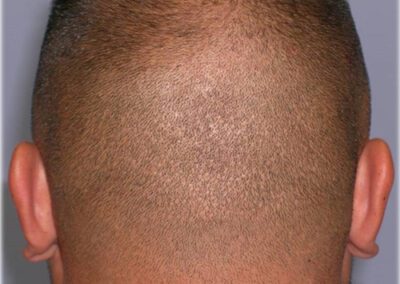Follicular Unit Extraction (FUE) Hair Transplant In Houston
Follicular Unit Extraction (FUE) is a method of harvesting donor grafts that removes one follicular unit at a time using a small (0.9 or 1.0mm) punch. These grafts can be harvested with a simple hand tool, a motorized hand engine, (SAFE, Neograft, or PCID systems), or by a physician-controlled robotic device.
FUE is a relatively new hair transplant technique, having only been used for about 15-18 years, and in common use for only 5 or 6 years. Every medical or surgical intervention or treatment has advantages and disadvantages, and it often takes years of experience to completely identify these risks and benefits. It is only in the last few years that some of these have been identified, as more hair transplant specialists are incorporating the procedure into their hair restoration practice.
The FUE punch grafting techniques are very close to those used to harvest the plug graft of the 1970’s and 80’s. The entire donor area must be shaved to get the grafts out, as the harvested grafts must be spaced evenly and as wide apart as possible to leave a natural looking donor area when the hair regrows. Dr Puig has been performing FUE surgeries for 9 years and has over 20 years of experience with punch grafting procedures.
Get a Free Consultation
Short Form - Free Hair Consultation
"*" indicates required fields
 DOWNLOAD OUR 10 REASONS Why you shouldn’t delay your Hair Restoration Surgery.
DOWNLOAD OUR 10 REASONS Why you shouldn’t delay your Hair Restoration Surgery.
FUE Donor Area Scarring
The most important advantage to FUE donor harvesting is that it leaves no linear scar on the back of the head. Therefore the patient has the option of wearing a very short or even shaved hair style.
The early marketing programs surrounding FUE stated that it was “a scar-less procedure”. That is just not true, as the body always heals with some type of scar. The average 0.9 to 1.0 mm FUE Excision leaves about 0.5 mm of scar on the scalp. The fact is that although FUE leaves no linear scar, the total scar left in the patient’s donor area is often 2 – 3 time greater than what a strip harvest would leave.
| Total # Grafts | # Procedures | Scar Characteristics | Total mm of Scar | |
|---|---|---|---|---|
| 3000 Strip | 1 | 25cm long | 3 mm | 750 sq.mm |
| 3000 FUE | 3 | 3300 attempts | 0.5mm/attempt | 1650 sq.mm |
| 6000 Strip | 2 | 27cm long | 4 | 1080 sq.mm |
| 6000 FUE | 6 | 6600 attempts | 0.5mm/attempts | 3300 sq.mm |
Several years ago, Dr. Puig and a few of his surgical colleagues noticed that large FUE surgeries often leave a “moth eaten” appearance in the donor area, that is only noticeable when the patient attempts to wear his donor area hair longer than 0.5 inches. They pursued research on whether this was a consistent finding and the cause of the issue. After years of observation and contemplation, the answer became apparent.
When one harvests a strip, the wound is closed with stiches that hold the wound edges together. Those stiches apply a tension to the skin above and below the wound proportional to the width of the wound. Whenever skin is put under stretching tension, the skin responds by stimulating mitotic activity to grow additional skin to remove the tension. This process is called biological creep, and is a body process commonly used in cosmetic surgery. For instance, if a woman has breast implants put in, the expansion of the implants stimulates biological creep, and new skin is formed so that the larger breast no longer feels tight and un-natural.
The FUE procedure does not cause any wound tension or stimulate any biological creep. The wounds heal by filling the holes with scar. Scar does not have the same light absorption properties of normal skin, and it reflects more light. Once a critical mass of scar is achieved in a given area, be it because of accidental or planned harvesting, the resultant scar will reflect more light, and cause the moth eaten appearance note b in fig 2.
The question is: what is the critical mass of scar that needs to be avoided? That probably is different for every patient, as it is dependent upon the color of hair and skin, caliper of the hair, curl of hair, and nature of the patient’s individual reaction to scar formation system.
Dr. Puig’s experience with this technique renders it a promising option for significant hair restoration. Although some scarring is unavoidable, with this thorough understanding of potential issues and constantly improving research on this topic, we are able to efficiently combat scarring and yield some of the best results in the industry.



